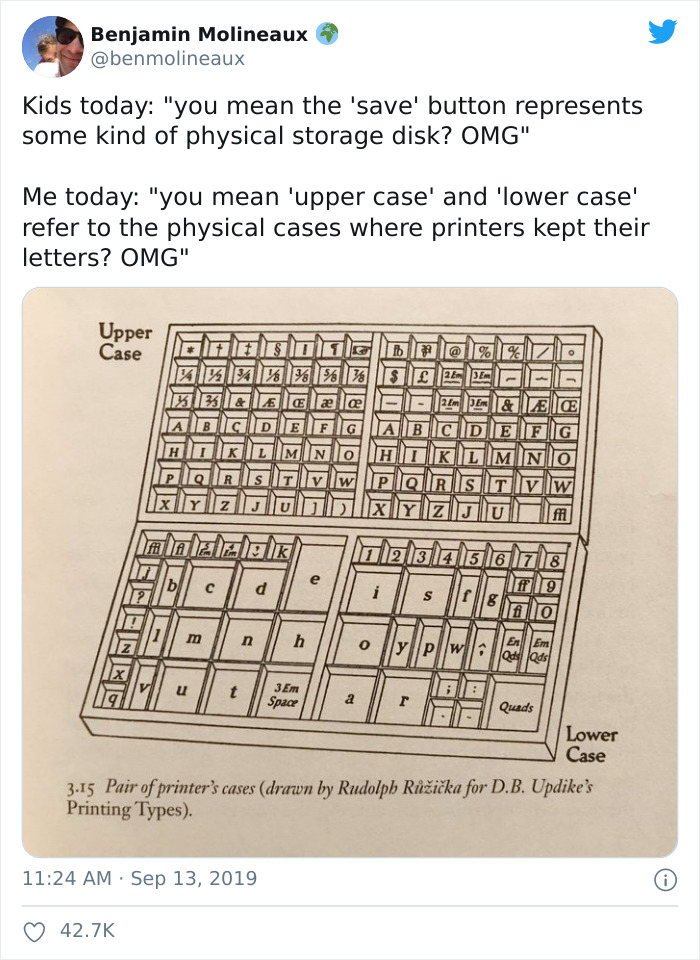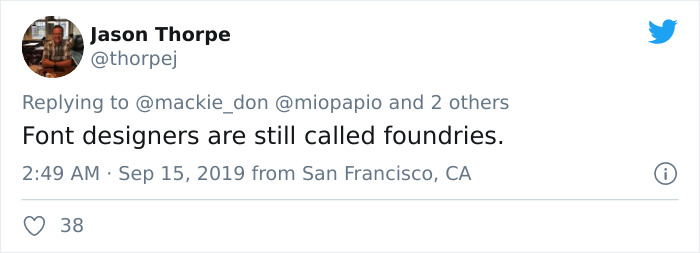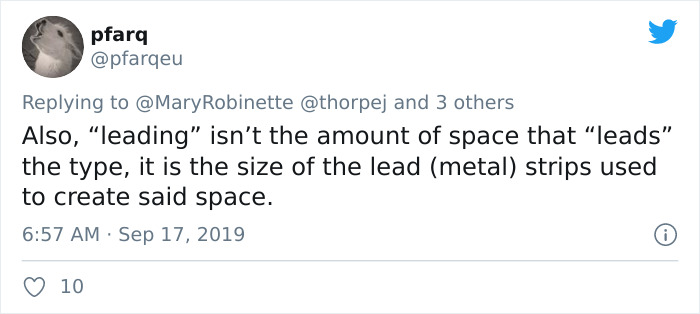People who have studied languages and literature can relate that most don’t understand what’s so fascinating about either of those things. In fact, they end up calling us the grammar police and that’s about it.
But when linguists start talking about etymologies—the origins of words—it’s quite often the case that non-linguists start showing massive interest in it, mostly because things begin making sense in their brains so much that they become giddy with such knowledge and they start to understand just how intricate, logical, and simply interesting language really is.
This kind of situation happened recently when Twitter user Benjamin Molineaux found out the original meaning of upper case and lower case. This was not only absolutely fascinating to others, but also prompted some people to share their own tidbits of etymological knowledge.
You’d be surprised to learn how many words sound a bit odd, but have very logical origins

Image credits: benmolineaux

Image credits: Maggie McCain
So, it all started with Twitter user Benjamin Molineaux posting a picture of a pair of printer’s cases (as illustrated in a book of some sort).
Jokingly, he said that kids today are surprised to learn that the save icon is actually a 3.5-inch floppy disk—because that’s where we used to save a lot of our digital things before all these terabytes we don’t know what to do with nowadays—and he, today, is surprised to learn that upper and lower case refers to actual cases, boxes.
These were used in old printing presses, with one part of the box containing all of the capitalized letters and the other having the non-capitalized ones. One is, hence, the upper case, the other is the lower case.
It all started off with one user explaining the origins of upper– and lowercase letters

Image credits: verstaen
This led to a number of people sharing similar typography-related terms and providing their etymologies, further blowing the minds of other tweeters.
And it lead to many others explaining the origins of other typographical terms and icon

Image credits: miopapio

Image credits: mackie_don

Image credits: thorpej

Image credits: pfarqeu
For instance, the word font has a common root with found and hence foundry, referring to how olden printing used to be done. Also, leading refers to the size of the lead strips used to create the spaces that lead the type.
Another lesser-known fact is that keyboards now have a shift key, which refers to the action of shifting the entire type bar on typewriters between upper and lowercase characters.
Needless to say, the terms cutting and pasting, while still being used today, refer to actual cutting of the printed text using scissors and pasting it using glue as part of the editing process.
Everything from fonts and foundries to leading and copy/pasting were mentioned in the thread

Image credits: HenninghamPress

Image credits: KatrinaTransfem

Image credits: MoonfacedAssassin

Image credits: MaxwellUltracynicLamb

Image credits: quizicist
This little fountain of knowledge quickly shifted to a whole different social media where it was elaborated upon by Tumblr user Peter Morwood with visual shorthand icons and graphics about writing still using fountain pens, typewriters, and the sort—as opposed to monitors, keyboards, and other modern tech actually used today.
It also discusses the aforementioned 3.5-inch floppy disks as well as the shape of the phone icon for accepting and ending calls—these are in the shape of a curved phone with a visible speaker and microphone part to it, whereas today’s most commonly used phones are in the shape of a slate.
The tweets also found their way to Tumblr, where Peter Morwood elaborated on it with writing icons





Image credits: petermorwood
The post also discussed the origins of phone depictions and elaborated on “save” icons









Image credits: petermorwood
People were so hooked on this that the tweet thread went viral. It garnered over 42,700 likes with almost 15,000 retweets on Twitter alone, with another 71,800 notes on Tumblr. Imgur also got a hold of this and the repost got over 91,000 views with almost 4,000 upvotes.
What are your thoughts on this? Have any interesting etymologies to share with other Pandas? Let us know in the comment section below!
from Bored Panda https://ift.tt/3c8s7b2
via IFTTT source site : boredpanda